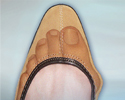Morton neuroma
Morton neuralgia; Morton toe syndrome; Morton entrapment; Metatarsal neuralgia; Plantar neuralgia; Intermetatarsal neuralgia; Interdigital neuroma; Interdigital plantar neuroma; Forefoot neuroma; Morton's neuroma
Morton neuroma is an injury to the nerve between the toes that causes thickening and pain. It commonly affects the nerve that travels between the 3rd and 4th toes.
Causes
The exact cause is unknown. Health care providers believe the following may play a role in the development of this condition:
- Wearing tight shoes and high heels
- Abnormal positioning of toes
- Flat feet
- Forefoot problems, including bunions and hammer toes
- High foot arches
Morton neuroma is more common in women than in men.
Symptoms
Symptoms may include:
- Numbness and tingling in the space between the 3rd and 4th toes
- Toe cramping
- Sharp, shooting, or burning pain in the ball of the foot and sometimes toes
- Pain that increases when wearing tight shoes, high heels, or pressing on the area
- Pain that gets worse over time
In rare cases, nerve pain occurs in the space between the 2nd and 3rd toes. This is not a common form of Morton neuroma, but symptoms and treatment are similar.
Exams and Tests
Your provider can usually diagnose this problem by examining your foot. Squeezing your forefoot or toes together bring on the symptoms.
A foot x-ray may be done to rule out bone problems. MRI or ultrasound can successfully diagnose the condition.
Nerve testing (electromyography) cannot diagnose Morton neuroma. But it may be used to check for conditions that cause similar symptoms.
Blood tests may be done to check for inflammation-related conditions, including certain forms of arthritis.
Treatment
Nonsurgical treatment is tried first. Your provider may recommend any of the following:
- Padding and taping the toe area
- Shoe inserts (orthotics)
- Changes to footwear, such as wearing shoes with wider toe boxes or flat heels
- Anti-inflammatory medicines taken by mouth or injected into the area between the toes
- Nerve blocking medicines injected into the toe area
- Other painkillers
- Physical therapy
Anti-inflammatories and painkillers are not recommended for long-term treatment.
In some cases, surgery is needed to remove the thickened tissue and inflamed nerve. This helps relieve pain and improve foot function. Numbness after surgery is permanent.
Outlook (Prognosis)
Nonsurgical treatment does not always improve symptoms. Surgery to remove the thickened tissue is successful in most cases.
Possible Complications
Complications may include:
- Difficulty walking
- Trouble with activities that put pressure on the foot, such as pressing the gas pedal while driving
- Difficulty wearing certain types of shoes, such as high-heels
When to Contact a Medical Professional
Contact your provider if you have constant pain or tingling in your foot or toe area.
Prevention
Avoid ill-fitting shoes. Wear shoes with a wide toe box or lower heels.
References
McGee DL. Podiatric procedures. In: Roberts JR, Custalow CB, Thomsen TW, eds. Roberts & Hedges' Clinical Procedures in Emergency Medicine and Acute Care. 7th ed. Philadelphia, PA: Elsevier; 2019:chap 51.
Shi GG. Morton's neuroma. In: Frontera WR, Silver JK, Rizzo TD Jr, eds. Essentials of Physical Medicine and Rehabilitation: Musculoskeletal Disorders, Pain, and Rehabilitation. 4th ed. Philadelphia, PA: Elsevier; 2019:chap 91.
Review Date: 4/24/2023
Reviewed By: C. Benjamin Ma, MD, Professor, Chief, Sports Medicine and Shoulder Service, UCSF Department of Orthopaedic Surgery, San Francisco, CA. Also reviewed by David C. Dugdale, MD, Medical Director, Brenda Conaway, Editorial Director, and the A.D.A.M. Editorial team.


